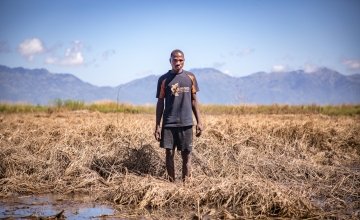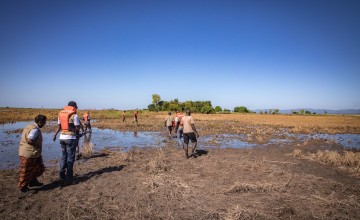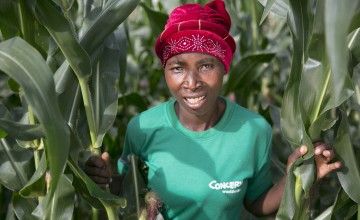
Read our 2023 annual report

Knowledge Hub
Cyclone Idai and the impact of climate change on agriculture

In March, Cyclone Idai ripped through Malawi in south eastern Africa, affecting over 840,000 people. The country’s farmers bore the brunt of the cyclone, with 63,000 acres of land destroyed, 23,000 animals killed, and homes flattened or flooded by the torrential winds and rains.
Agriculture in Malawi
With a population of approximately 17 million, Malawi is ranked among the poorest countries in the world. Agriculture is the largest economic activity in Malawi, accounting for up to 80 per cent of the country’s export earnings. While the average farm size in Ireland is 32 hectares, many of the farmers there are small holders with less than one hectare and their foods are grown primarily for household consumption, with a surplus sold to local markets. Maize accounts for nearly half of smallholder-cultivated land followed by groundnut, bean, cassava, sweet potato, and other food crops.
Malawi has a sub-tropical climate, which is relatively dry and strongly seasonal. The warm-wet season stretches from November to April, during which 95 per cent of the annual rains fall. Farmers usually plant their crops at the beginning of the rainy season and harvest in March.

Malawi is susceptible to extreme weather, severe flooding in 2015 and 2018, and pro-longed dry spells and droughts in 2016, 2017 and last year have resulted in widespread crop and livestock devastation. Agriculture in Malawi relies mostly on rain for irrigation with 95% of the rain falling between November and April. This allows only for one growing season. Outside of severe weather events crops and animals still remain susceptible to climate variability with heavy rains and prolonged dry spells.
This year’s maize crop was looking very promising. It was just weeks from being harvested when Cyclone Idai struck. The winds, heavy rains and flash floods destroyed the fields of crops, denying families of a favourable harvest.


The impact of climate on global agricultural productivity
Climate change is predicted to have significant impacts on agricultural productivity at a global level. The effects of climate change will primarily influence agriculture through alterations in plant growth, water availability, nutrient availability, increased temperature and elevated CO2 levels. The biophysical effects of climate change on agriculture induce changes in production and prices, altering crop mix, input use, production, food demand, food consumption, and trade.
Climate change will have the greatest impact on agriculture in developing countries primarily because many farms in the low latitudes already endure climates that are already hot. Ireland however, is not climate change proof and the effects of extreme weather have already started to impact agriculture in developed countries.
Extreme weather already having an impact on Ireland
Ireland saw weather extremes in 2018, with snow cover until the end of March and a prolonged dry spell in the following months. The extreme snowfall and low temperatures pushed the winter/feeding season out by almost six weeks and the dry period left farmers with a fodder deficit coming into the winter of 2018.
This resulted in major challenges for dairy, beef and tillage farmers, with livestock farmers forced to use stocks of silage intended for the following year and divert silage ground into grazing ground. Tillage farmers found that crops sown in spring failed to mature properly, which has a significant impact on yield.
Conservation agriculture in Malawi
In Malawi, conservation agriculture gives farmers an opportunity to deal with the changing climate and apply new practices. Conservation agriculture is a response to sustainable land management, environmental protection and climate change adaptation and mitigation. It is guided by three principles; minimal soil disturbance, permanent soil cover and crop rotations.
Livestock farmers in Malawi are encouraged by Concern advisors and extension workers to de-stock and re-stock according to the immediate risk of drought or floods. This provides an opportunity for farmers to reduce the risk of losing their livestock and livelihoods through a simple mechanism. Often times farmers end up selling their livestock for significantly less than their value. This is far from ideal as farmers are often offered lower prices in desperate times. Both in Ireland and Malawi, farmers need to be supported by policy to ensure that they are given a fair price for their livestock during weather and fodder crises.

The benefits of conservation agriculture in a changing climate
The important benefits of conservation agriculture include greater rainfall infiltration, resulting in increased rainfall use efficiency, early planting, reduction in soil erosion, enhanced soil biological activity and reduction in amount of labour hours. Irish tillage farmers could adopt similar practices such as crop cover, minimum tillage or crop rotations to help retain moisture and nutrients.
Supporting recovery
In addition to working with farmers to train them regarding conservation agriculture, Concern is working with farmers in the wake of cyclone to get them back on their feet as quickly as possible. With funding from Irish Aid, it is distributing tools and seeds to farmers to enable them plant a winter crop which should be ready to be harvested in June or July.


All farming practices rely on the weather and developed countries are no different from developing countries. When unexpected weather hits, it doesn’t matter whether you are using sophisticated technology or subsistence agriculture as all types of agriculture are dependent on favourable weather. Farmers globally are vulnerable to the effects of climate change and we need to share our knowledge to ensure that livelihoods are protected in the coming years.
Help those affected by Cyclone Idai


